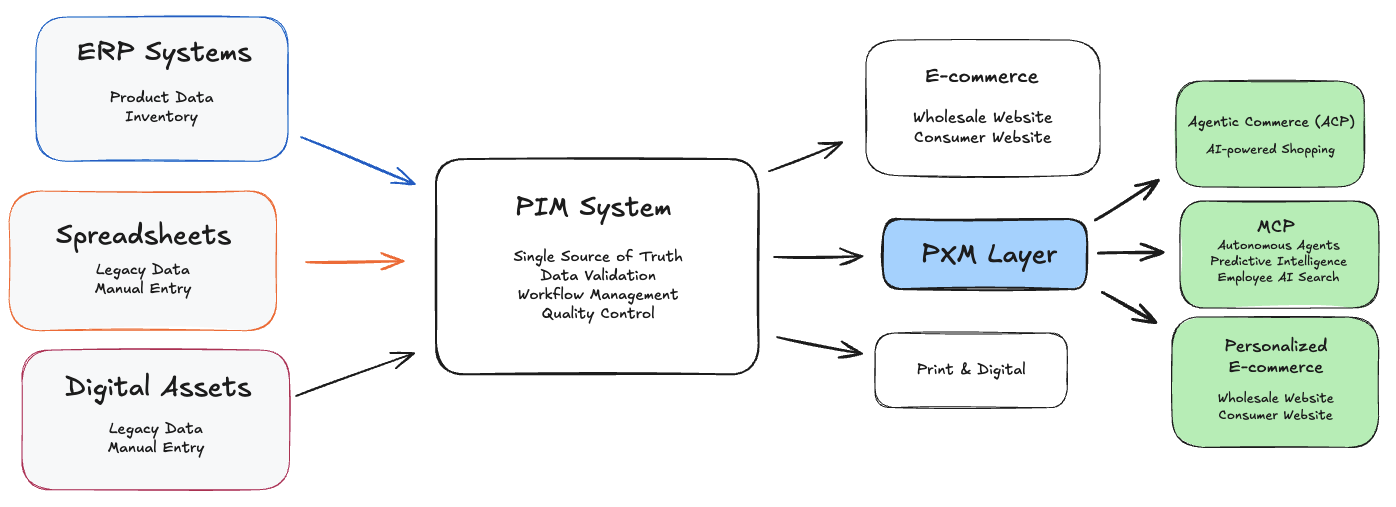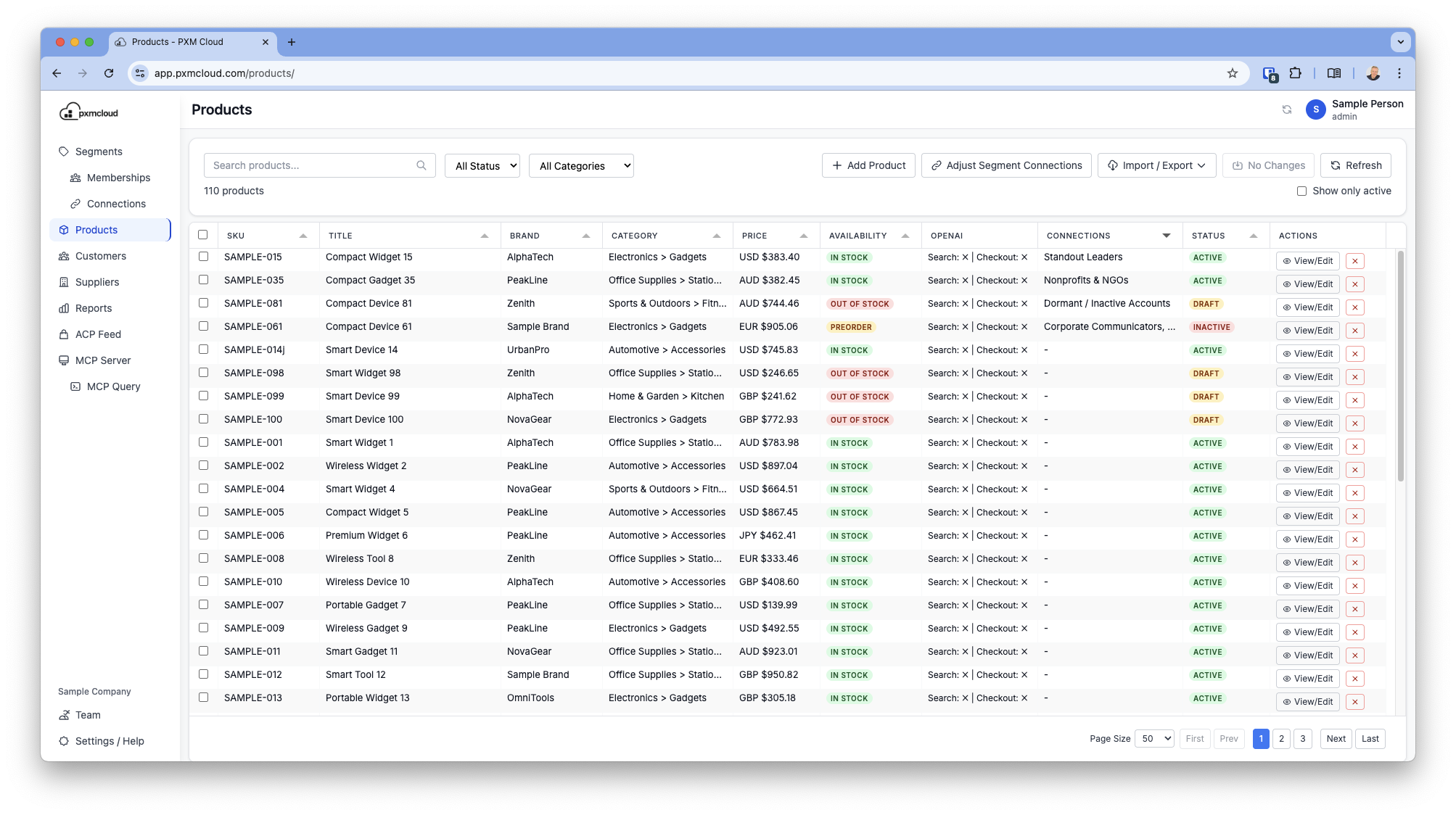What is Product Information Management?
PIM
Product Information Management (PIM) is a comprehensive system designed to centralize, organize, and distribute all product-related information across an organization. A PIM system serves as the single source of truth for product data, including names, SKUs, technical specifications, attributes, dimensions, pricing, digital assets (images, manuals, videos), regulatory information, and marketing content.
Unlike scattered spreadsheets, ERP systems, or individual e-commerce platforms, PIM ensures consistency, accuracy, and completeness across all sales channels. It supports complex workflows including translation, versioning, approval processes, and multi-team collaboration, enabling organizations to maintain data integrity while scaling their product catalogs efficiently.
PIM is essential for any organization managing complex product catalogs, multiple sales channels, or international operations where data consistency and accuracy are critical to business success.
How PIM Systems Can Be Used
PIM systems serve multiple critical functions within modern commerce operations:
Data Centralization
Consolidate product information from multiple sources (ERP, spreadsheets, legacy systems) into a single, authoritative repository. Eliminate data silos and ensure all teams work with the same, up-to-date information.
Multi-Channel Distribution
Automatically syndicate product data to various sales channels including e-commerce websites, marketplaces (Amazon, eBay), social commerce platforms, print catalogs, and in-store systems.
Content Management
Manage rich product content including high-resolution images, videos, 360-degree views, downloadable assets, and marketing copy. Organize content by product variants, seasons, or campaigns.
Workflow Automation
Implement approval workflows for product launches, content updates, and pricing changes. Enable role-based access controls and automated notifications to keep teams aligned.
Internationalization
Support multiple languages, currencies, and regional requirements. Manage localized product descriptions, compliance information, and market-specific attributes.
Data Quality & Governance
Implement data validation rules, completeness checks, and quality scoring. Ensure compliance with industry standards and regulatory requirements across all markets.
Industries Where PIM is Critical
PIM systems are essential across numerous industries, each with unique requirements and challenges:
Retail & E-commerce
Why PIM matters: Managing thousands of SKUs across multiple channels with varying product attributes, seasonal collections, and regional variations.
Examples: Fashion retailers managing size charts, color variants, and seasonal collections; Electronics retailers handling technical specifications, compatibility matrices, and warranty information; Home goods companies managing dimensions, materials, and assembly instructions.
Manufacturing & Industrial
Why PIM matters: Complex technical specifications, compliance documentation, and multi-tier distribution networks require precise data management.
Examples: Automotive parts suppliers managing OEM specifications and compatibility; Industrial equipment manufacturers handling safety certifications and technical drawings; Chemical companies managing safety data sheets and regulatory compliance.
Food & Beverage
Why PIM matters: Nutritional information, allergen data, and regulatory compliance vary by region and require constant updates.
Examples: CPG companies managing ingredient lists and nutritional facts across markets; Beverage companies handling alcohol content and regional labeling requirements; Food service distributors managing temperature requirements and shelf life data.
Healthcare & Pharmaceuticals
Why PIM matters: Regulatory compliance, clinical data, and safety information must be accurate and up-to-date across all markets.
Examples: Medical device companies managing FDA approvals and clinical trial data; Pharmaceutical companies handling drug interactions and dosage information; Healthcare equipment suppliers managing maintenance schedules and safety protocols.
B2B & Wholesale
Why PIM matters: Complex product hierarchies, technical specifications, and customer-specific pricing require sophisticated data management.
Examples: Industrial suppliers managing product catalogs for different customer segments; Wholesale distributors handling tiered pricing and customer-specific product availability; B2B marketplaces requiring standardized product data from multiple suppliers.
Fashion & Apparel
Why PIM matters: Size charts, seasonal collections, and trend-based product lines require flexible data structures and rapid updates.
Examples: Fashion brands managing seasonal collections and trend forecasting; Footwear companies handling size conversions and style variations; Accessories companies managing color and material combinations.
PIM's Relationship to Customer Relationship Management
PIM provides the foundational product data that, when combined with Customer Relationship Management (CRM) systems, powers Product Experience Management (PXM). While PIM focuses on product data accuracy and consistency, CRM provides customer intelligence, and PXM transforms both into compelling, personalized customer experiences.
Think of PIM as the product data foundation that ensures all product information is correct, complete, and up-to-date. CRM is the customer intelligence layer that understands who customers are and what they need. PXM is the experience layer that combines product data with customer insights to create personalized experiences. Together, they create a powerful ecosystem where accurate product data and customer understanding enable exceptional experiences.
Learn more about how PIM, CRM, and PXM work together in our comprehensive overview of the complete customer and product management ecosystem.

Key Benefits of Implementing PIM
Operational Efficiency
Eliminate manual data entry, reduce errors, and streamline product launch processes. Centralized data management reduces time-to-market for new products and updates.
Data Quality & Consistency
Ensure accurate, complete product information across all channels. Implement validation rules and quality controls to maintain data integrity.
Multi-Channel Excellence
Distribute consistent product information to websites, marketplaces, print catalogs, and in-store systems without manual duplication.
Scalability & Growth
Support business growth with systems that can handle increasing product complexity, new markets, and expanding sales channels.
Team Collaboration
Enable cross-functional teams to work together on product information with role-based access, approval workflows, and version control.
Compliance & Governance
Maintain regulatory compliance across different markets and industries with automated data validation and audit trails.
Tip: Start with a PIM implementation to establish clean, complete product data as your foundation. This enables effective PXM strategies and creates a scalable platform for growth.

